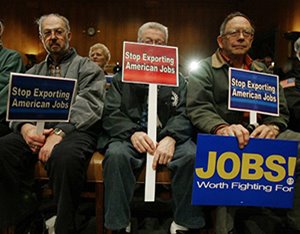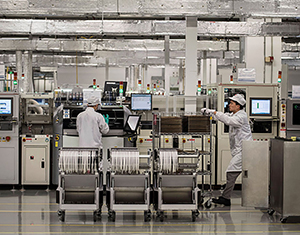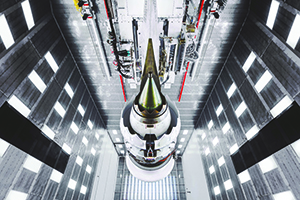How to Bring Engineering and Manufacturing Jobs Back to America
How to Bring Engineering and Manufacturing Jobs Back to America


As more industrial R&D is done overseas, American manufacturing is at even greater risk.
After decades of offshoring manufacturing, the United States is losing the ability to create wealth from its investment in research and development. America’s longstanding offshoring strategy, “Invent here, manufacture there,” has been gradually becoming, “Invent there, manufacture there.”
More and more research is done overseas. Yes, federal R&D at U.S. universities and national labs continues to unlock scientific mysteries. Yet more and more research involving manufacturing and scale up is done overseas. As a result, the United States is losing its ability to translate taxpayer-funded research into mass production—and jobs, knowledge, wealth, and national security.
This is a dangerous trend for a developed country and it is clearly visible. Take, for example, lithium-ion batteries. The United States led the world in basic research until the 1990s, but U.S. battery companies Duracell and Eveready abandoned full-scale production in the 90s due to lack of patient capital and insufficient profit margins.
Sony and Panasonic picked up where Americans left off. Thanks to Tesla, which partnered with Panasonic on its giant Li-ion U.S. battery plant, the United States retains a 22 percent share of the global Li-ion market. Meanwhile, China dominates global production and is adding new capacity rapidly.
Or, consider an advanced nanoelectronics technology developed by University of Texas-Austin with federal research dollars. The school licensed it to Japan’s Canon because U.S. firms lacked the capital, precision manufacturing infrastructure, engineering skills, and production know-how to bring it to market.
Similar fates befell other technologies developed in the United States, from solar cells, robots, and flat panel displays to smartphones, drones, and flexible displays. In fact, by 2016, the United States had a positive trade balance in only two advanced industries: aerospace and jet engines and turbines. Even in medical devices and pharmaceuticals, where the federal government is the single largest customer, the nation does not maintain a positive trade balance.
End of an Era
What we are seeing—unfortunately, in hindsight—is the end of an era that began after World War II.
During the war, the United States was an engineering and manufacturing powerhouse. It excelled at converting European scientific ideas into mass produced new products. Its ability to convert manufacturing might into guns, ammunition, tanks, ships, and aircraft earned it the title, “Arsenal of Democracy.”
Further Reading: The State of American Manufacturing 2019
But the United States did not win World War II on production alone. Scientific advances created new inventions that ranged from radar and the Norden bombsight to artillery proximity fuses and, of course, the atomic bomb.
The dynamo funding many of these advances was Vannevar Bush, co-founder of Raytheon and former dean of MIT’s engineering school. During the war, he headed the U.S. Office of Scientific Research & Development, which managed nearly all defense research.
After the war, Bush argued that scientific research was vital to both national security and economic wealth. He was instrumental in founding the National Science Foundation, whose large and sustained funding still supports basic research today.
Many U.S. corporations also established R&D labs, including such luminaries as GE Corporate R&D, IBM Watson Research Center, Xerox PARC, and AT&T Bell Labs. These labs (and others) worked with national labs and universities to tackle major research projects and convert their findings into products.
Military contracts for development and procurement created markets for innovations at their earliest stages of development. They bankrolled everything from jet aircraft, semiconductors, telecommunications, lasers, computers, and robots. It also bank-rolled the growth of Silicon Valley.
For 30 years, this model made the United States the global leader in science, innovation, and manufacturing. It created many things we take for granted today, from jet aircraft, semiconductors, and MRI machines to lasers, computers, robots, and manufacturing automation.
This model no longer works. Since the mid-70s, the United States has led the world in science and scientific discoveries. Yet federal R&D investments have failed to create the national wealth and jobs.
In fact, for the past two decades, major U.S. manufacturers have invested more in stock buybacks and financial instruments than in capital equipment for domestic production.
What caused this to happen?
A Different World
One problem is that we invest in science, not engineering. Science creates knowledge but not wealth. Engineering applies that knowledge to create national wealth and security.
This distinction may sound trivial, but agencies that fund research think of engineering as a subordinate field of science. This impacts how they spend federal research dollars.
During the 90s, for example, federal support of chemical, electrical, and mechanical engineering declined by 25 percent, 30 percent, and 55 percent, respectively. Meanwhile, funding for biological and medical sciences rose more than 20 percent.
Over the past decade, total federal research expenditures rose 8.1 percent, again led by life sciences. Engineering was the only “scientific” field where research expenditures fell, by 4.3 percent. During that time, the National Science Foundation devoted $1.3 billion to STEM (science, technology, engineering, and mathematics) education. Only 1 percent went to engineering education.
Further Reading: The Impact of Tariffs on Engineering and Manufacturing
At the same time, that world has changed in ways that diminish the nation’s ability to generate national wealth from discoveries and inventions.
First, as global economies became more entwined, another offshoring production has emerged as a foundational strategy for American manufacturers. This trend accelerated after China, with its low labor rates and inexpensive currency, joined the World Trade Organization in 2001. Many U.S. manufacturers found that offshoring production was a relatively fast route to lower production costs, boost profit margins, and serve both the domestic and foreign markets. Unfortunately, this led to plant closings, job losses, and manufacturing infrastructure decay.
At the same time, large public corporations, such as AT&T, IBM, Motorola, GE, GM, and many others, changed how they thought about industrial R&D. Instead of long-term investment, they redefined their mission as boosting shareholder value, with its emphasis on short-term corporate earnings.
This led to a significant decline in long-term corporate R&D. With the exception of software, biotech, and pharmaceuticals, most R&D focuses on development, specifically short-term incremental innovations and enhancements to existing product.
At the same time, federal R&D spending (mostly research) fell from roughly 2 percent of GDP in the 1960s to less than 0.75 percent in recent years. The vast majority of that goes to science, not engineering.
Nor are private investors funding manufacturing startups. The United States has the largest, most sophisticated capital markets in the world, yet venture capitalists are unwilling to invest in risky long-term, capital-intensive manufacturing facilities. Instead, they seek quick returns and instant scale up from software and biotechnology. In fact, less than 4 percent of venture capital goes to manufacturing start-ups.
This is not true for our global competitors. They recognize the importance of translating basic research into products and processes that generate wealth and jobs. Thanks to the openness of U.S. research universities, other nations can let the United States do the basic research while they spend their money on translational research.
In 2016, for example, the U.S. federal R&D budget was roughly $150 billion—significantly more than other advanced industrial nations and four times as much as that of Germany. Yet, the United States invested a mere $773 million (0.52 percent) on translational research in engineering and manufacturing.
Compare that with Germany, which spent $4.34 billion, or six times more than the United States; Japan, which spent three times more; and S. Korea, which spent eight times as much.
These advanced economies all have high labor costs, high energy costs, and strict regulations. They all face Chinese competition. Yet all of them have maintained strong advanced manufacturing sectors while U.S. output has declined.
Today, more and more corporate R&D is moving offshore. This is not just to move closer to manufacturing, but to take advantage of readily available suppliers, talented engineers, and production experts. In fact, American companies accounted for nearly half of all foreign R&D centers established in China.
As a result of lost production capacity and know-how, hardware start-ups have a difficult time scaling production in the United States. This was brought home by an MIT study of 150 MIT hardware start-ups. All had access to talent and research capital. None were able to scale production in the United States. Many ended up manufacturing in China—often pushed there by investors who believe Chinese production is faster and cheaper, despite potential downsides.
Government’s Role
To fix the dismal state of American hardware innovation and production, think of the innovation cycle as a baseball diamond. Getting to first base begins with investments in basic research that lead to promising discoveries and inventions.
Second base involves supporting in translational research—engineering R&D and prototyping—to create prototypes and bench-scale processes.
Third base is the transition to pilot production. Engineers must demonstrate they can manufacture products at scale cost effectively, reliably, and safely.
Companies score at home when they overcame the challenge of full-scale manufacturing. This often generates inventions that trigger further discoveries and new products as the cycle continues.
America’s investments in research-oriented R&D guarantee a footing on the first base and sometimes second base. But unless innovators round third and go home, the nation does not score, let alone win.
You May Also Like: Manufacturing Takes Flight
In the early post-war period, the American system won consistently. Today, this model has broken down.
Take, for example, collaborations between offshore companies and American universities. They give foreign competitors easy access to graduates and federally funded research results. But without federal funding for translational research, foreign entities are in a position to license the technology or to offer affordable production. Similar gaps exist at every stage of the innovation cycle.
The Trump Administration’s focus on corporate tax rates and tariffs may have changed the calculus of global production, but so far it has done little to re-shore production. Clearly, a new model is needed to rebuild lost capabilities—not industries—and rekindle American ingenuity.
That starts with a strategy. The United States is the only developed country without a strategy to turn basic research investment into jobs, wealth, and national security. Market forces alone will not do this. The private sector will continue to offshore manufacturing and R&D as long as it improves its bottom line.
This is why government has an indispensable role to play—just as it has done since Alexander Hamilton established America’s first planned industrial development in Patterson, N.J. Government support made possible everything from transnational railroads and the commercial aerospace to the internet.
Today, sustained, strategic investments are needed to fill the gaps in our innovation cycle, so the United States can earn a full return on its research investment.
In 1950, Vannevar Bush helped found the National Science Foundation to manage federal research funding. Today, we need an agency whose sole mission is to develop manufacturing programs and policies. It would provide a strategic focus to 56 existing programs spread across 11 agencies and ensure our long-term ability to innovate and compete.
We should fund it with an additional 5 percent of the existing $150 billion the federal government now spends on science and technology, or $7.5 billion. It may sound like a lot, but it is dwarfed by our trade deficits with China and the lost opportunity to manufacture American inventions here.
Several have suggested a similar agency. Michigan Senator Gary Peters, for example, proposed a National Institute of Manufacturing, modeled on the National Institutes of Health, to invest in translational R&D. Other ideas include creating a National Manufacturing Foundation or a Technology & Manufacturing Directorate within the National Science Foundation.
Five Steps to the Future
To succeed, such an agency must address five critical needs.
First, the United States needs to dramatically increase funding for translational research through grants and contracts for engineering and manufacturing R&D.
We should establish a series of university Translational Research Centers run in partnership with the private sector. The centers would provide the infrastructure needed to build and test prototypes, and support professional engineering and business development. By advancing the technical and manufacturing readiness levels of new technologies, they would reduce private enterprise’s risk of scaling up new technologies for mass production.
Second, we should create public-private investment funds to support pilot production and scale up. These funds would leverage government (and especially defense) procurement to create initial markets for new technologies, especially in emerging industries.
Third, the United States should empower small and medium-sized manufacturers—the overwhelming majority of manufacturers—to compete globally. This aid might range from accelerating the use of smart manufacturing technologies and creating simpler ways to license university technologies to increasing access to expert advice and new markets.
Further Reading: A Robot for the Every-Factory
Fourth, the United States must take aggressive steps to rebuild its engineering talent. We should promote four-year engineering technology programs that prepare students with much needed hands-on skills. We should increase the number of graduate fellowships significantly to entice qualified domestic students to learn new skills. And we should incentivize the private sector to boost the number and availability of engineering and manufacturing apprenticeships for high school and college students.
Finally, we need legislation that requires that any product or its derivative based on federally funded research be substantially manufactured—say, 75 percent of value added—in the United States. This offer should be open to both domestic and overseas firms, as long as they are willing to invest here. Otherwise, American taxpayers will continue to subsidize research that creates wealth in other countries.
For decades, America’s industrial might—and its ability to create wealth and good-paying jobs for everyone—has been eroding. Over the past 20 years, that gradual decline has become a landslide, putting the U.S. economy and national security at risk. Publishing another study or a new report will not add much value to what we already know. We need to act.
Other advanced countries have robust industrial policies and long-term national strategies. The United States needs one too, one that embodies a commitment that stretches beyond election cycles and quarterly profits.
We need a commitment to engineering that parallels the infrastructure we have created in science, one that puts the “&” back in R&D. The long-term wealth and security of the nation depend on it. The onus is on us.
Sridhar Kota is executive director of MForesight: Alliance for Manufacturing Foresight and the Herrick Professor of mechanical engineering at University of Michigan.








